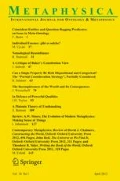Abstract
Among biological kinds, the most important are species. But species, however defined, have vague boundaries, both synchronically owing to hybridization and ongoing speciation, and diachronically owing to genetic drift and genealogical continuity despite speciation. It is argued that the solution to the problems of species and their vague boundaries is to adopt a thoroughgoing nominalism in regard to all biological taxa, from species to domains. The base entities are individual organisms: populations of these compose species and higher taxa. This accommodates all the important biological facts while avoiding the legacy problems of pre-evolutionary typological taxonomy, which saw species and other taxa as prior to their members. Species are however not individuals: they are spatiotemporally bounded collections, which are plural particulars.
Similar content being viewed by others
Notes
I proposed this in a letter to Ernst Mayr and he did agree that the idea of a highly scattered individual was strained.
I have been advocating concrete pluralities since Simons (1980).
The type of a genus or higher taxon is a type of one of the species subordinate to it.
In unpublished work with Yu Lin, we propose a nominalist account of DNA sequences, using mereology and a nominalistic account of sequences (strings).
Ibid.
References
Alström P (2006) Species concepts and their application: insights from the genera Seicercus and Phylloscopus. Acta Zool Sinica 52 (Suppl): 429–434.
Dobzhansky T (1935) A critique of the species concept in biology. Phil Sci 2: 344–355.
Fine K (1975) Vagueness, truth and logic. Synthese 30: 265–300.
Ghiselin M T (1974) A radical solution to the species problem. Syst Zool 26: 536–44.
Hull D I (1976) Are species really individuals? Syst Zool 25: 174–191.
Kitcher P (1984) Species. Phil Sci 51: 308–333.
Liebers D, de Knijff P and Helbig A J (2004) The herring gull complex is not a ring species. Proc Roy Soc Lond B 271: 893–901.
Mayr E (1942) Systematics and the origin of species from the viewpoint of a zoologist. Columbia University Press, New York. Reprinted Harvard University Press, Cambridge, 1999.
Simons P M (1980) Individuals, groups and manifolds. In: Haller R and Grassl W (eds) Logic, language and philosophy. Hölder-Pichler-Tempsky, Vienna.
Simons P M (1999) Does the sun exist? The problem of vague objects. In: Rockmore T (ed), Proceedings of the XX World Congress of Philosophy. Vol. II: Metaphysics. Philosophy Documentation Center, Bowling Green.
Simons P M (2010) Supernumeration: vagueness and numbers. In: Dietz R, and Moruzzi S (eds) Cuts and clouds: vagueness, its nature and its logic. Oxford University Press, Oxford: 482–490.
Simpson G G (1961) Principles of animal taxonomy. Columbia University Press, New York.
Vrana P B and Wheeler W C (1992) Individual organisms as terminal entities: laying the species problem to rest. Cladistics 8: 67–72.
Woese R, Kandler O and Wheelis M L (1990) Towards a natural system of organisms: proposal for the domains Archaea, Bacteria, and Eucarya. Proc Nat Acad Sci 87: 4576–4579.
Author information
Authors and Affiliations
Corresponding author
Glossary
- Category
-
A class the members of which are all the taxa placed at a given level in a hierarchic classification (Simpson 1961: 19)
- Liger
-
Offspring of a male lion and a tigress
- Taxon
-
A group of real organisms recognized as a formal unit at any level in a hierarchic classificationFootnote 5
- Tigon
-
Offpring of a male tiger and a lioness
About this article
Cite this article
Simons, P. Vague Kinds and Biological Nominalism. Int Ontology Metaphysics 14, 275–282 (2013). https://doi.org/10.1007/s12133-013-0127-0
Published:
Issue Date:
DOI: https://doi.org/10.1007/s12133-013-0127-0



